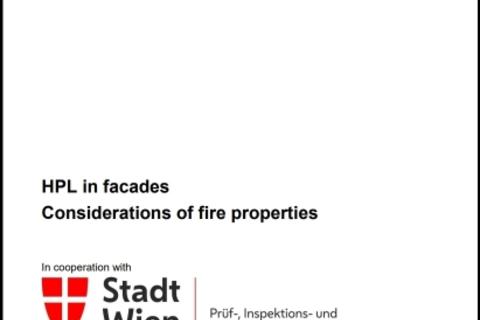Leaflet on fire behaviour of HPL in façades

How does an exterior façade react
with regard to fire development if HPL-Compact is installed in it? This
question was investigated by experts from the Testing, Inspection and
Certification Services (Prüf-, Inspektions- und Zertifizierungsstelle)
of the City of Vienna on behalf of the International Committee of the
Decorative Laminates Industry (ICDLI). Their conclusion: Flame-retardant
HPL-Compact withstands the fire scenarios specified in national medium
and large-scale tests; vertical fire spread from the cladding to other
floors and surrounding objects as well as burning drops causing
secondary fires do not occur with a ventilated façade made of HPL panels
as cladding. ICDLI has now published these and other results in a
leaflet entitled "HPL in the façade – considerations on the fire
properties".
For HPL panels in exterior applications, the highest possible level of safety in terms of fire protection always comes first. To this end, the products of the ICDLI member companies undergo the most stringent fire tests. The results go directly into product development – always adapted to country-specific fire protection regulations, as there are no harmonised building regulations for façades in Europe.
Experiences from fires and fire tests in the laboratory prove that the spread of a fire through the façade is a relevant hazard scenario. If one takes the case of a fire in a room, it often spreads further along the façade. In such a case, it depends in particular on the properties and characteristics of the façade itself how the fire develops.
HPL-Compact: plus points for fire behaviour
HPL-Compact equipped with flame retardants as part of a ventilated façade lands in the best possible class for this type of material in the European classification scheme in terms of temperature rise, fire spread and falling particles. This has now been independently confirmed by the testing body, Inspection and Certification Services of the City of Vienna. Thus, cladding with HPL panels for ventilated façade systems is a fire-safe solution, as the Austrian experts concluded. In all tests known to the authors, neither burning drops nor horizontal fire spread were observed.
However, according to the authors of the study, the following conditions must be met in the planning and execution of façades for this to occur:
- an application of HPL on buildings up to the high-rise limit (legal requirement)
- HPL with flame-retardant properties
- structural parameters tailored to fire protection, such as the substructure, the size of the rear ventilation gap, the use of horizontal fire barriers, etc.
- compliance with relevant European, national and local regulations
- the system erected on site must strictly comply with tested and classified products
Planning and execution of façades
Generally speaking, when it comes to fire protection in façade construction, it is not only the fire safety of the individual building materials that counts, but the entire façade construction. This includes, for example, the insulation, connection technology and composite panels. Each individual component determines how safe the façade is as an overall system. The present leaflet gives building planners, architects and engineers the assurance that HPL panels, which are usually made of organic materials, are safe for exterior use and thus help to protect human life and property.
The leaflet is published as a download on the ICDLI website.
Press release as pdf document
About ICDLI
The ICDLI is the international representation of the European laminates manufacturers. The association aims at creating a strong and successful European community of the manufacturers as well as at the continuation of the success story of HPL.
Press contact
ICDLI – International Committee of the Decorative Laminates Industry aisbl
Dr. Patrick Kohlas
Phone +49 69 40 89 555 46
E-Mail patrick.kohlas@pro-kunststoff.de
Internet www.icdli.com
